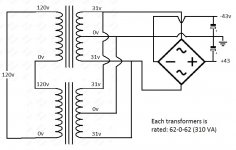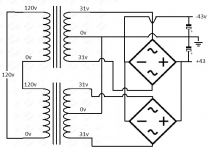I have 2 identical center-tapped transformers that I bought on the cheap at a surplus store years ago. The secondary voltages are 62v-0-62v (much too high for the IRAUDAMP7 amplifier's I have). I was thinking that if I connect the primaries of the 2 transformers in series, then parallel the secondaries, I'd effectively get one large 31v-0-31v transformer.

Can I do this? If so, how would this effect the total VA rating? Is the VA rating of these transformers based on the transformer's core size or the guage of the wires? I'm hoping to get more or less 31v-0-31v and 620VA.
Thanks

Can I do this? If so, how would this effect the total VA rating? Is the VA rating of these transformers based on the transformer's core size or the guage of the wires? I'm hoping to get more or less 31v-0-31v and 620VA.
Thanks
As far as I can see, it should work. Good thinking.
The power as such depends on the gauge of the windings (impedance). But in order to get room for the windings you need a core of a certain size and you must not drive the core into saturation. With the same core material, the core-size effectively increase with power.
Your windings are not optimized for that core when you have only half the primary voltage and the impedance is higher than it ought to be. Therefore, you have less than 620VA.
The power as such depends on the gauge of the windings (impedance). But in order to get room for the windings you need a core of a certain size and you must not drive the core into saturation. With the same core material, the core-size effectively increase with power.
Your windings are not optimized for that core when you have only half the primary voltage and the impedance is higher than it ought to be. Therefore, you have less than 620VA.
Last edited:
You are putting 60V on a winding designed for 120V. To a first approximation, current is the same, voltage is half, VA is half. 155VA each, 310VA both together.
If you paid full price, this is bad economics. Since you "bought on the cheap", the economics are good. The size is much larger than an optimized transformer. In portable (guitar amp) work this is bad. A lump in the living room does not move so this may be acceptable.
That voltage promises 100+ Watts into 8 Ohms, or 200W stereo. 310VA for 200W audio out is not generous, and may sag very badly in sustained test-tone bench-check. For unclipped speech/music it will not be strained.
If you paid full price, this is bad economics. Since you "bought on the cheap", the economics are good. The size is much larger than an optimized transformer. In portable (guitar amp) work this is bad. A lump in the living room does not move so this may be acceptable.
That voltage promises 100+ Watts into 8 Ohms, or 200W stereo. 310VA for 200W audio out is not generous, and may sag very badly in sustained test-tone bench-check. For unclipped speech/music it will not be strained.
I would exchange them with the supplier or stick them on ebay and buy the right transformer for the job.
Rewire it to have the secondaries within one transformer in parallel, then put the transformers (the parallel secondary pairs) in series. Secondary windings must be identical to be allowed to put in parallel, otherwise large currents will flow. There is a better chance that the secondaries are identical within one transformer than between two similar looking transformers.
Last edited:
Bear in mind that any scheme which puts separate power transformer primaries in series must ensure near enough identical current draw from each secondary over the whole AC cycle. Your original circuit did this reasonably well. Separate bridges begins to move away from this, unless you can be sure the bridges are identical.
Having the secondaries in parallel will go a long way in ensuring the series primaries are running equal voltage, such that sharing is reliable. Using the bridge is a nice idea, but removes the forced sharing to a degree. Were the primary windings in parallel, the bridges would be a nice feature.
- Status
- Not open for further replies.
- Home
- Amplifiers
- Power Supplies
- 2 transformers. Primaries in series / Secondaries in Parallel
